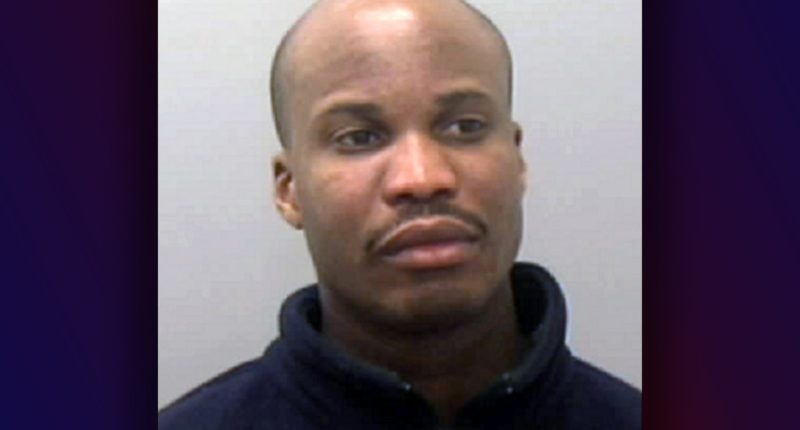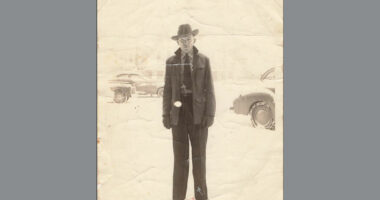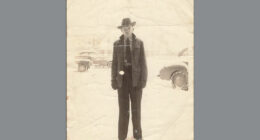Share this @internewscast.com
A serial killer wouldn’t live to tell where he discarded the bodies of countless Black women in the St. Louis area.
Unknown Serial Killers of America delved into the chilling case of Maury Travis, who enticed at least a dozen victims to his home in the suburbs of St. Louis, situated in Ferguson, Missouri. There, the seemingly charming food server would bind, degrade, and torture his victims — mainly sex workers struggling with addiction — before breaking the fourth wall in his haunting homemade videos.
Detective Jana Walters of the St. Charles County Sheriff’s Office noted the “pure evil” of Travis.
Bodies found in and around St. Louis in 2001
In May 2001, a grass cutter in St. Charles County, Missouri, stumbled upon the nude body of a Black woman by the roadside. Her identity was confirmed as Teresa Wilson, thanks to a distinctive upper dental plate. Although she battled with addiction, she was dearly loved by her family.
Despite late-stage decomposition, investigators believed the location of the body was a secondary site and that she died elsewhere.
Then, one month later and less than 20 feet from where Wilson was discovered, missing Illinois woman Verona Thompson was found in a similar manner.
“This was horrendous,” commented Walters. “These women, irrespective of their profession, are mothers, daughters, sisters, aunts … They don’t deserve to die like this.”
Missouri detectives and Illinois State Police compared notes, finding similarities between Wilson and Thompson to victims Alysa Greenwade and Betty James, both of whom were left in East St. Louis over the state border.
Due to the many municipalities in the area, not all the victims’ deaths were immediately connected, according to authorities.
“By the end of the summer, it was one after another after another,” said former St. Louis Police Department Captain Harry Hegger. “We were really shocked by the monthly occurrence that a sex worker — found nude, sometimes undetermined cause [of death] or strangulation — would turn up in a multitude of jurisdictions.”
FBI Agents, like married couple John and Melanie Jimenez, were called in to assist.
The creation of a task force
Federal, state, and local law enforcement agencies formed a task force, and they spent months canvassing the streets and chasing leads to no avail. Then, in the fall of 2001, experts extracted the suspect’s DNA when the bodies of Yvonne Crues and Brenda Beasley were discovered in East St. Louis.
In early 2002, investigators uncovered three still-unidentified Jane Does.
But their most significant break came after a reporter at the St. Louis Post-Dispatch wrote a May 19, 2002 article, a profile humanizing murder victim Teresa Wilson.
“It showed that even though she was a sex worker, she did have a life,” said St. Louis P.D. Detective Kenneth Dye. “She had friends, and she had family, and she fell into a rut, and she couldn’t get out.”
Days later, someone purporting to be Wilson’s killer wrote a demanding letter to the media outlet, along with a map of where authorities could find his alleged 17th victim.
A serial killer taunts the media
The letter, dated May 25, 2002, stated:
“Nice sob story about Teresa Wilson. Write one about Greenwade. Write a good one, and I’ll tell you where many others are. To prove I’m real, here’s directions to number seventeen. Search a 50-yard radius from the X. Put the story in the Sunday paper like the last.”
Sure enough, the map — generated from an online website — led authorities to another body.
“In the middle of a field, very visible by a little gravel road, we did see that it was a sun-bleached skull,” Walters told Unknown Serial Killers of America. “And, upon looking further into the area, there were scattered bones, remains of a skeleton.”
Capt. Hegger said the fourth Jane Doe was left “a short distance” from where they found Wilson and Thompson.
“This is our guy,” he said.
A forensic examination of the note showed a St. Louis postmark with a return address that led to an S&M website. The unknown serial killer left no DNA, and attempts to track down where the stationery came from were fruitless.
However, thanks to Agents John and Melanie Jimenez, authorities had the mapping website subpoenaed, and a digital investigation led to an IP address in Ferguson, Missouri.
Living alone at the residence was Maury Travis.
Authorities home in on suspect Maury Travis
Maury Travis was a local food server, paroled since his 2000 release from prison for a string of robberies in the late 1980s. Beginning June 4, 2002 — following the lead from the IP address — the task force carefully watched his comings and goings, specifically to glean whether he frequented areas high in prostitution and sex trafficking.
Task Force members noticed Travis regularly took out the trash at his single-family home, owned by his Illinois-based mother.
“They stopped the trash man about a block or so over and said, ‘Hey, we wanna ride with you and pick up trash; we wanna get trash from this one house,’” Hegger said. “So, they picked it up, and inside the back of the trash truck was this brand-new, empty container that we dumped all the trash into.”
Within a day, DNA recovered from a discarded plastic spoon matched the DNA found with the bodies of Crues and Beasley.
Maury Travis’ “chamber of horrors”
Authorities executed a warrant to search Maury Travis’s home on June 7, 2002. They were surprised when they entered, finding a neat and tidy home without “a speck of dust,” according to Dye.
A few investigators pulled Travis aside while others continued searching the home. When confronted with pictures of the victims, he continually denied any knowledge.
John Jimenez and others made their way downstairs to the basement, finding a TV room with a floor-to-ceiling bookshelf lined with VHS tapes of home videos and children’s animated films. And, further down the hall, investigators discovered a locked door.
“When they opened the door, the overpowering aroma of the blood and bodily fluids quickly overcame the investigators,” Dye said. “Travis had tried to use room deodorant down there and everything, but the smell was too strong.”
According to John Jimenez, the room was painted an “unusual” blue, with dark carpeting and a mattress on the floor. A bag nearby contained a stun gun, restraints, and duct tape.
“It looked like what you’d consider a kit that a serial killer would use,” the agent said.
Blood spatter was found on the walls of an adjacent closet. According to Dye, “there were chains, ligatures, boards with blood on them … you could see it was a chamber of horrors.”
Later, FBI crime scene technicians found blood within the layers of paint covering the walls.
“There was so much blood hidden in the walls,” Walters said. “He painted over it. He killed. Blood. Paint. Killed. Blood. Paint. This went on for layers and layers.”
Behind the bookshelf, investigators found dozens of VHS tapes containing Travis’s horrific acts. In them, Travis degraded the victims, often forcing them to refer to him as “Master” or ridiculing them as mothers.
In one video obtained by Unknown Serial Killers of America, Travis broke the fourth wall after one of his murder victims lay spread on the floor.
“First kill is 19 years old,” he said. “Name? I don’t know. I don’t give a f–k.”
For law enforcers tasked with watching the videos of women’s torture and murders, counseling was made available.
“Maury Travis had a rather ritualistic way that he would kill his victims,” said psychological criminologist Bryanna Fox. “He would tell them they were going to die, make them confess for their sins, or make them say that they were happy to be his servant.”
Hegger also touched on Travis’ “sadistic streak,” as evidenced in audio published by Unknown Serial Killers of America.
“You want to say something to your kids?” Travis is heard asking one of his victims.
Maury Travis is jailed
Travis gave up denying his role as a serial killer while en route to police headquarters in St. Louis. Hegger found him “cocky” and “arrogant” back at the station, but Travis promised to confess all once appointed a public defender.
“When you hear that a task force searched and tracked down the monster that was amongst us, a serial killer, it’s like a roller coaster of emotion,” former East St. Louis Mayor Dr. Debra Powell said. “You’re excited, but then when you find out he grew up right here, it’s mind-boggling.”
The crimes begged the question: What made Maury Travis a serial killer? The answer wasn’t apparent, since Travis was raised by a loving mother and devoted much of his youth to volunteering at nursing homes and churches. He joined the U.S. Army Reserves before heading to Atlanta, Georgia to study business at Morris Brown College.
That’s when people first reported a personality shift.
“He picked up a cocaine habit, flunked out of business college, and returned to St. Louis,” Dye said. “And, in order to support his cocaine habit, he held up a number of shoe stores. He was tracked down and charged with armed robbery, convicted in 1989, and sentenced to 15 years in prison.”
Travis was released in 2000, not long before the discovery of his first known victim, Teresa Wilson.
Investigators looked forward to hearing what Maury Travis had to say, but on June 10, 2002, he hung himself with a bedsheet while sitting behind bars. In a suicide note left for his mother, Travis confessed, “I’ve been sick for a long time (sick in the head) since I was 14.”
He gave no further information about his crimes.
“A lot of those women may never be recovered,” Hegger admitted.
However, in light of the map Travis sent, referring to the skeletal remains of his alleged 17th victim, investigators believe Travis killed upward of 20 women in total, possibly dozens. Det. Dye believes there is “damn sure more than 20” based on the frequency of the killings.
Former Mayor Powell told Unknown Serial Killers of America that Maury Travis’ crimes weren’t widely reported because people “turned a blind eye” to the victims due to their lifestyles. She hoped anyone with information would come forward in the hopes of finding more victims.
“The families are still hurting, and everyone needs closure,” she said.
Tune in to all-new episodes of Unknown Serial Killers of America, airing Sundays at 7/6c on Oxygen.










